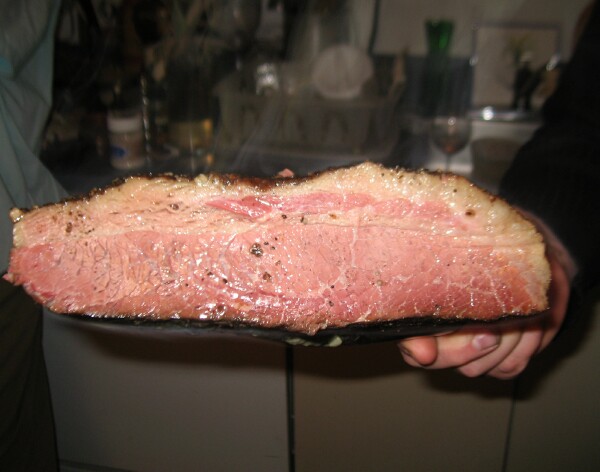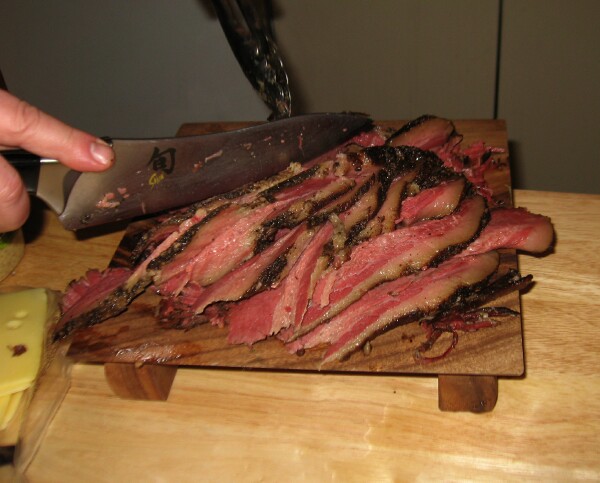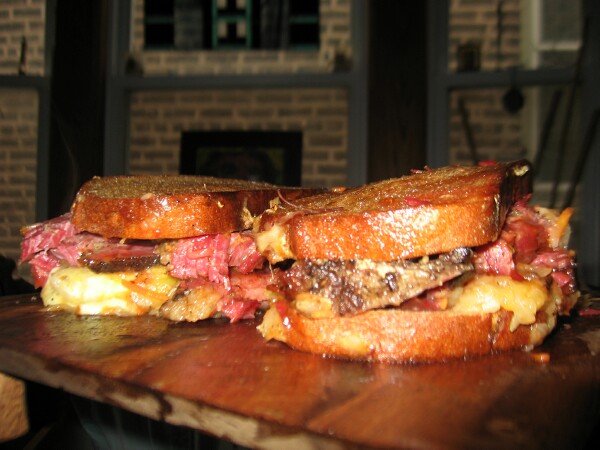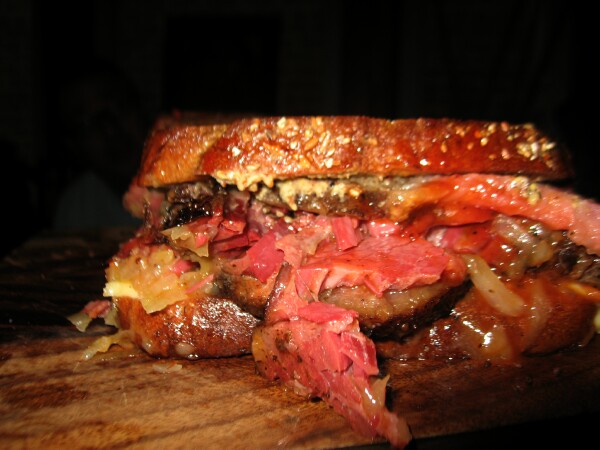Homemade Pastrami & Bacon
Homemade Pastrami & Bacon
-
-
-
-
-
-
Post #31 - December 5th, 2006, 9:11 amextramsg wrote:
1) It looks like the cure didn't quite penetrate all the way. There appears to be a little uncured spot. Get a meat injector and inject the brine into the thicker portions of the brisket. Also, if you feel along the brisket, you'll find dense, hard spots. I stab the hell out of these to help the brine penetrate.
Not sure if it was from the flash or what, but the cure definately penetrated all the way through. It had a uniform deep pink color from edge to edge.
Jamie
-
-
Post #32 - December 5th, 2006, 9:39 pmYeah, inject prior to the cure. Currently, we do a deli brunch every Saturday out of a friend's restaurant and just signed a letter of intent on a hotel restaurant property in downtown Portland for a full-time deli.
-
-
Post #33 - December 16th, 2006, 4:44 pmextramsg wrote:Yeah, inject prior to the cure. Currently, we do a deli brunch every Saturday out of a friend's restaurant and just signed a letter of intent on a hotel restaurant property in downtown Portland for a full-time deli.
LTH,
In another thread I wished Extramsg luck in his upcoming Portland, Oregon deli venture, after recently tasting his pastrami I now know luck will have nothing to do with his success. Nick, aka Extramsg, gave Jazzfood, who was in Portland on business, pastrami to take home for both him and Erik M, who then generously shared their bounty over lunch at Jazzfood's house.

I thought Extramsg nailed the pastrami, in particularly texture and balance of fat content, though I was initially ever so slightly off-put by the sweet note which penetrated the meat. I am a heritage eater of pastrami, read Jewish growing up eating in deli's, and am used to a less sweet, more aggressive flavor profile.

After just a few bites I realized Extramsg's pastrami was so well made the undercurrent of sweet was a conscious, well thought out, decision on his part and started appreciating it for what it was, pastrami that did not fit my particular pastrami paradigm. Extramsg had suggested Jazzfood make rubens with at least part of the pastrami, which worked particularly well, the bit of sweetness balancing nicely with pan toasted rye, sauerkraut, Swiss cheese and Russian dressing.
Jazzfood makes a mean ruben!

This was among the best rubens I've had, really terrific. Extramsg, how about opening up a Chicago branch once you get up and running in Portland?
Enjoy,
Gary
-
-
Post #34 - December 16th, 2006, 8:37 pmThanks. I think you give me too much credit for what was a conscious decision. I've been playing with the sugar and other amounts for a while now. This last week I lowered the amount of brown sugar significantly. I think that gives it a more traditional NY flavor. Either way it's good to me. It's an artisan product, though, and week to week things change because it's humans making the product with pieces of meat that vary, temperatures and times that vary, etc. We're getting more consistent, though.
-
-
Post #35 - December 16th, 2006, 8:53 pmextramsg,
Have you ever tried dextrose - 70% less sweet than sugar? I use it for all my cures, but especially good for beef IMHO. Seems to enhance the beef favor rather than adding sweetness.
Bill/SFNM
-
-
Post #36 - December 16th, 2006, 9:04 pmHaven't. We actually use a combination of sugars -- white, brown, and honey. So there is flavor being added with the sweetness.
-
-
Post #37 - December 16th, 2006, 9:14 pmHI,
Jazzfood brought me a small portion of the pastrami to taste. It was really a very fine product, which everyone has already attested to.
I'm sure your deli will be a destination restaurant.
Thanks for sharing the bounty Erik and Jazzfood. extramsg - thank you for sending it out here.
Regards,Cathy2
"You'll be remembered long after you're dead if you make good gravy, mashed potatoes and biscuits." -- Nathalie Dupree
Facebook, Twitter, Greater Midwest Foodways, Road Food 2012: Podcast
-
-
Post #38 - December 17th, 2006, 10:59 pmBill/SFNM wrote:Have you ever tried dextrose - 70% less sweet than sugar? I use it for all my cures, but especially good for beef IMHO. Seems to enhance the beef favor rather than adding sweetness.
Interesting. Bill, what's your source for dextrose (glucose)? I've wondered why it isn't available in drugstores as it can quickly boost blood-sugar levels (I suppose gatorade has that market).
-
-
Post #39 - December 17th, 2006, 11:16 pmI got some dextrose at the Spice House, though I don't think they actually sell it; I just asked nice. They use it in some of the spice blends.
Jamie
-
-
Post #40 - December 17th, 2006, 11:47 pmsazerac wrote:
what's your source for dextrose
sazerac,
I get most of my unusual ingredients from The Ingredient Store. Dextrose is listed under Barbecue, Sausages, Marinades and Curing. Joe Ames, the owner, is a great resource and a great guy and will promptly respond to emails. He's in your state, Pennsylvania.
Bill/SFNM
-
-
Post #41 - December 18th, 2006, 7:20 pmwhat's your source for dextrose
Homebrewing supply shops carry it. It is also called corn sugar.
Kitduck fat rules
-
-
Post #42 - December 31st, 2006, 9:47 pmA bit of a postscript -- or perhaps a virtual postcard. I spent the last couple days in LA and hit Langer's, Canter's, and Nate and Al's. I thought all three were good and Langer's excellent. I was primarily there for pastrami. LA is a great pastrami town. It's all over the place. I have pictures of multiple places with signs that read: "Burgers, Tacos, Tamales, Pastrami" etc. Pastrami burgers are a staple. I'd only seen them in Utah before. And while the pastrami burgers I've had at Crown Burger and Royal Burger in Salt Lake and Provo were slightly better than the ones I had at Nate and Al's and Pete's Blue Chip, they were all three damned close in quality. (I've been bugging Ken, my business partner, for a while now to use the leftovers for his burger on his normal menu.)
Honestly, I think these three LA delis are better than the three most famous Manhattan delis: Katz's, Stage, and Carnegie. I realize Stage and Carnegie are touristy, but Nate and Al's is in the middle of Beverly Hills and Canter's is open 24/7 and has to serve a diverse crowd. (Langer's is in the middle of a Latin neighborhood.) Of course, this is based on limited experience with each. But just an impression of them. And there's no doubt that NY has more depth, especially as you move out into Brooklyn and Queens.
The real reason I'm writing this, though, is that I was surprised at how sweet the pastrami at Langer's was. Sweeter than our sweetest stuff, I would say. Less smokey, too, which was no surprise. And now that I've dialed back the sweetness to a point that I'm happy and dialed up the spices, we're much less sweet. Somewhere between there and NY, perhaps. This was true of the other LA delis, too, but not as much as Langer's.
Also, now I understand when people come in and say that we needed a seeded cornmeal crusted rye. They're LA deli people. That's all they had in LA, but I never saw it in NY, where the rye was always unseeded and a little darker, maybe a 30%-40%, just guessing. And it was never crusted with cornmeal.
-
-
Post #43 - January 16th, 2007, 1:09 pmnick,
next time you're in l a check out johnnies pastrami on sepulveda in culver city."In pursuit of joys untasted"
from Giuseppe Verdi's La Traviata
-
-
Post #44 - January 20th, 2007, 3:59 pmextramsg wrote:Looks great. I've been making 80 lbs of pastrami a week for about 6 or more months now. A couple quick suggestions:
1) It looks like the cure didn't quite penetrate all the way. There appears to be a little uncured spot. Get a meat injector and inject the brine into the thicker portions of the brisket. Also, if you feel along the brisket, you'll find dense, hard spots. I stab the hell out of these to help the brine penetrate.
2) Smoke it longer than 5 hours. I suggest getting it closer to 180 degrees before taking it off. We give them more like 10 hours of oak and charcoal.
3) Use the fattiest brisket you can find or the leanest plate you can find. Either way. So much pastrami out there is way too lean and the fat has so much flavor. Note, however, that the fattier and thicker the stuff, the tougher it will be to get the cure to penetrate.
4) If you're using Charcuterie's recipe, I'd suggest doubling the amount of pickling spice. And most pickling spice blends are too low in mustard seed and coriander, imo. Add more of those.
extramsg,
Do you have any revised opinions on this in early December, which I am basing on your comments in late December:The real reason I'm writing this, though, is that I was surprised at how sweet the pastrami at Langer's was. Sweeter than our sweetest stuff, I would say. Less smokey, too, which was no surprise. And now that I've dialed back the sweetness to a point that I'm happy and dialed up the spices, we're much less sweet. Somewhere between there and NY, perhaps. This was true of the other LA delis, too, but not as much as Langer's.
I am contemplating making a batch of pastrami in the very near future and would like to incorporate your ideas.
Regards,Cathy2
"You'll be remembered long after you're dead if you make good gravy, mashed potatoes and biscuits." -- Nathalie Dupree
Facebook, Twitter, Greater Midwest Foodways, Road Food 2012: Podcast
-
-
Post #45 - January 20th, 2007, 4:32 pmHI,
I found an interesting article on making bacon from the University of Missouri Extension. I found a few excerpts which may shed light on bacon making:
Bellies prepared from skinned carcasses may be cured successfully in the same manner as those from scalded carcasses.
So skin on or off doesn't affect the method.A cure mixture that performs well under home curing conditions consists of 7 pounds meat curing salt, 4 pounds sugar (white or brown) and 3 ounces of nitrate (saltpeter -- optional). This cure produces a milk-flavored bacon.
Applying cure
If commercially prepared cure is used, apply according to the manufacturer's instructions. If you prepare your cure according to the suggested recipe, apply the cure at rate of 1/2 ounce per pound fresh belly. If you cannot weigh the ingredients and bellies, you can put the cure on by sprinkling the skin side and by rubbing the sides and inside well with the cure. Hold the belly on edge and tap gently on table to remove excess cure. The amount applied will equal about 1/2 ounce per pound.Curing time
Stack the bellies crisscross no more than four layers deep on a table that is tilted to allow the moisture to drain away. Plywood on a set of sawhorses works well.
This is a departure from our instructions where the liquid coming from the bacon create the brine. In this cited information it is preferable to eliminate the moisture.Preparation for smoking
Wash the bacon in warm water, hang in the smokehouse with door open and allow to dry. This may take two or three days. The meat will not take smoke until the surface is dry. If the meat is smoked when still damp, the smoke will be smudgy and the meat will not taste as good.
Drying the bacon before smoking is not related to texture, rather the ability of the meat to cling to the smoke.Handling the finished product
Bacon cured and smoked in this fashion is perishable and needs to be frozen or stored in a refrigerator until eaten. Remove the rind if it is not removed during slaughter, slice, wrap in freezer paper and freeze. The sliced bacon will retain its quality 2 to 3 months in freezer storage. If more bacon was cured than the family will eat in two to three months, wrap and freeze in chunks. Bacon will keep its fresh flavor longer during freezer storage if it is not sliced.
In this article there is information on how to construct a smoke chamber as well as bacon hangers. If I only lived on a farm, then I could do it all!
Regards,Cathy2
"You'll be remembered long after you're dead if you make good gravy, mashed potatoes and biscuits." -- Nathalie Dupree
Facebook, Twitter, Greater Midwest Foodways, Road Food 2012: Podcast
-
-
Post #46 - January 20th, 2007, 5:31 pmWhen hot-smoking bacon, I've found that having the skin on the belly makes it less likely to curl up during the process. Of course, optimally, it never gets hot enough in your smoker to cause curling, but if the temp should creep up along the way, smoking it skin-on guards against the curling, somewhat.
I also find that smoking with the skin-on makes for a better looking product, as the fat atop the belly is nearly pure white after you remove the skin. When you smoke skin-off, the top of the belly definitely gets darker and not always in an attractive way.
=R=By protecting others, you save yourself. If you only think of yourself, you'll only destroy yourself. --Kambei Shimada
Every human interaction is an opportunity for disappointment --RS
There's a horse loose in a hospital --JM
That don't impress me much --Shania Twain
-
-
Post #47 - January 20th, 2007, 11:39 pmHere's the latest recipe:
6 gallons of water
7 cups kosher salt
1 1/8 cup pink salt
5 cups white sugar
2 cups brown sugar
3/4 cup honey
1/2 cup pickling spice
1/4 cup coriander seed
1/4 cup mustard seed
1/3 cup minced garlic
It brines for about a 5 to 6 days.
-
-
Post #48 - January 20th, 2007, 11:50 pmextramsg,
Thanks for the recipe.
How many briskets are you brining in this solution?
Regards,Cathy2
"You'll be remembered long after you're dead if you make good gravy, mashed potatoes and biscuits." -- Nathalie Dupree
Facebook, Twitter, Greater Midwest Foodways, Road Food 2012: Podcast
-
-
Post #49 - January 21st, 2007, 12:28 amIt does 6 or 7 pretty easily. We shuffle them around daily.
-
-
Post #50 - January 21st, 2007, 12:29 amextramsg wrote:It brines for about a 5 to 6 days.
And you do some injecting too, right?
=R=By protecting others, you save yourself. If you only think of yourself, you'll only destroy yourself. --Kambei Shimada
Every human interaction is an opportunity for disappointment --RS
There's a horse loose in a hospital --JM
That don't impress me much --Shania Twain
-
-
Post #51 - January 21st, 2007, 8:41 pmYep, just did that today in fact. I'd say I go through about 8 cups of brine for every six nose-off briskets. (Some of that will squirt out, though.) I mostly focus on the parts of a brisket thicker than about an inch or so. I also stab the parts of a brisket that feel dense and stiff where you can't really inject any brine.
-
-
Post #52 - February 2nd, 2007, 12:51 pmThere are many options for the cut of beef used for making pastrami (whole brisket, brisket points, brisket flats, round, navel, corned briskets, etc.). I've had extremely good results lately taking a whole brisket (big beautiful NR ones) and cutting off the exposed flat leaving the point and the piece of flat that runs beneath it. The removed flat is great for braises. The point/flat chunk is the perfect size for curing and smoking and produces big juicy slices. In the photos below, you can see the two portions of the brisket in a single slice. Note also the slices are relatively thick. IMHO, the true test of perfectly smoked brisket is to be able to cut off thick slices that hold together but are still tender as butter. Today's lunch also consisted of freshly baked rye bread.
The cured brisket bathing in pecan smoke:
The grain of the point and the grain of the flat run in different directions. Sliced across the flat grain since it tends to be tougher.

Bill/SFNM
-
-
Post #53 - February 2nd, 2007, 1:08 pmWow, Bill. I want to taste that sandwich so badly. It is truly a thing of beauty.
-
-
Post #54 - February 2nd, 2007, 1:14 pmLooks nice. Maybe we should do a pastrami exchange.

We started with plate but got complaints about it being too fatty. Some people absolutely loved it, but we were using Painted Hills beef and there were some rivers of fat -- looked like pork belly -- at times. Then we switched to whole briskets and we still got complaints about the point. Personally, that's what I prefer. Now we only use flats. We keep the fat cap on, of course, though. If people don't like that, sorry, they can go to the other delis in town and have Hebrew National for all I care.
I'm hoping we can switch to whole briskets when we go full-time and offer people the choice of "regular" or "lean".
-
-
Post #55 - February 2nd, 2007, 1:21 pmAnytime, extramsg! But remember that I'm just an amateur and you're a pro.
I agree that the point is the best! Pastrami without fat is like lobster without the tail. But that piece of flat that spends 14+ hours being basted by the point sitting above it is darn tasty.
Bill/SFNM
-
-
Post #56 - March 9th, 2007, 5:13 pmHi,
I am finally about to embark in making corned beef/pastrami. I have a 17 pound packer's cut brisket, which is a lot of brisket. I consulted Charcuterie to find they expected one to use a 5 pound brisket.
I am of two minds about what to do: cut in in half, though if I did, can someone recommend the best approach? Or leave it whole and deal with it as it is, though I will need to triple recipe at least the cure.
Now if I cut the brisket in half, then I might cure both pieces of meat finishing one as corned beef and the other as pastrami. (Of course I can freeze for another day)
Any thoughts?
Regards,Cathy2
"You'll be remembered long after you're dead if you make good gravy, mashed potatoes and biscuits." -- Nathalie Dupree
Facebook, Twitter, Greater Midwest Foodways, Road Food 2012: Podcast
-
-
Post #57 - March 9th, 2007, 5:23 pmCutting the brisket could be dicey because it will be difficult to do so in a way which yields some point and some flat in each portion. Of course, someone out there has probably given this more thought than I have. Perhaps there is a tried and true brisket-splitting method floating around out there.
As for the pink salt, I'm not sure you need to triple that, even if you're tripling the recipe. I don't have the specific information in front of me, but I think that you might be able to safely use less. I'll check my notes asap.
=R=By protecting others, you save yourself. If you only think of yourself, you'll only destroy yourself. --Kambei Shimada
Every human interaction is an opportunity for disappointment --RS
There's a horse loose in a hospital --JM
That don't impress me much --Shania Twain
-
-
Post #58 - March 10th, 2007, 7:55 amronnie_suburban wrote:Of course, someone out there has probably given this more thought than I have.
Ron,
I don't know about more thought, but I have given the question some thought. I recommend setting the raw brisket in from of you (Cathy) point (deckle) to the left, flat to the right. You will notice the point side is higher and, as it moves to the flat, slopes downward. The point contains two sections, flat and a fattier part which together are referred to as the point.
I recommend cutting the brisket where the point ends, in other words, where the meat, looking from the left, ceases to slope downward.
If Cathy is going for both pastrami style and corned beef style I recommend using the flat, the less fatty part, for corned beef and the point for pastrami as the highly marbled point will be less likely to dry out in the smoker.
Or Cathy can simply whack the brisket in half and be done with it in 30-seconds.
Enjoy,
Gary
-
-
Post #59 - March 10th, 2007, 8:30 amHI,
Thanks Gary for a good strategy on how to best cut and use the brisket. My nieces will like the corned beef, though they might like the pastrami. This brisket is so large, it can accomodate both tastes very well. While I was tempted to cut it in half, I was sure there was a better idea!
Once Suburban Ronnie advises the pink salt aspect when multiplying a recipe, then I am good to go.
Thanks!
Regards,Cathy2
"You'll be remembered long after you're dead if you make good gravy, mashed potatoes and biscuits." -- Nathalie Dupree
Facebook, Twitter, Greater Midwest Foodways, Road Food 2012: Podcast
-
-
Post #60 - March 10th, 2007, 8:52 amCathy.
You would need to increase the amount of cure proportionally as you increase the amount of liquid. i.e. 1T cure-1 gallon water or 2 T to 2 gallons.
I hope 17 lbs wasn't too big. That's what Bill brought out. You should get a few meals out of it. I bought a case of briskets and 4 corned beefs while I was there.

